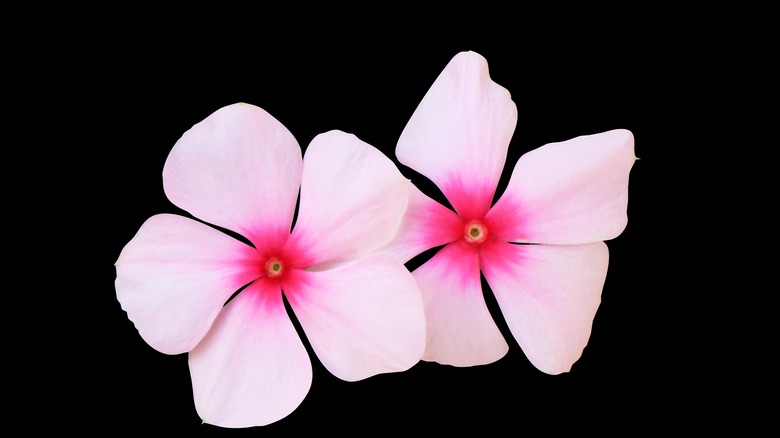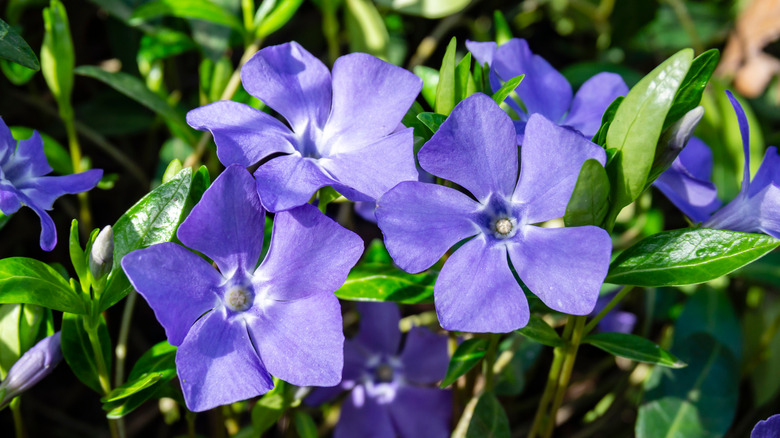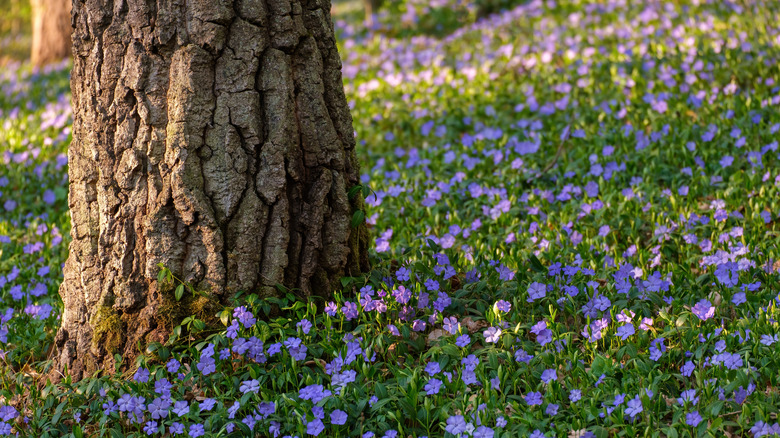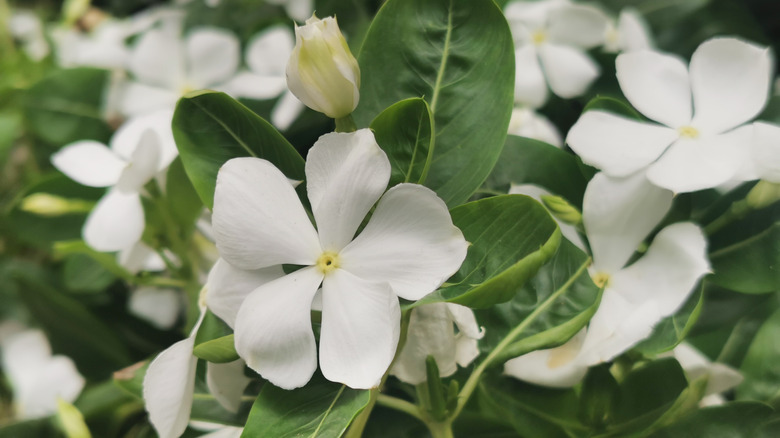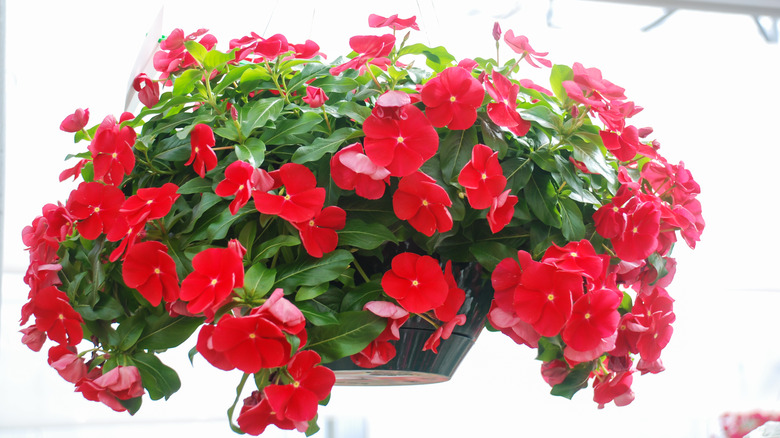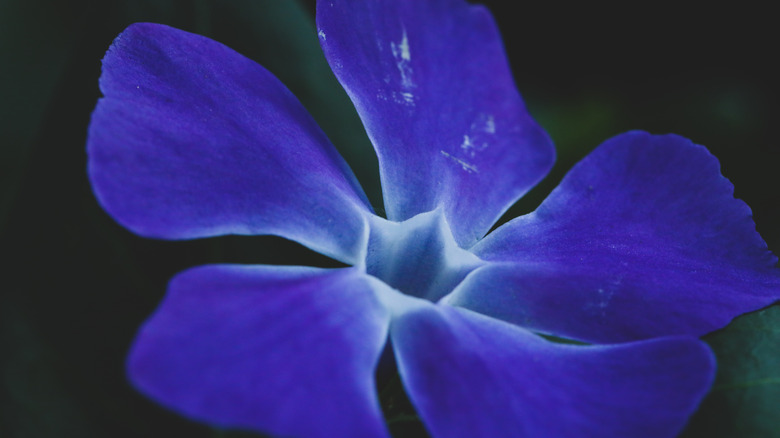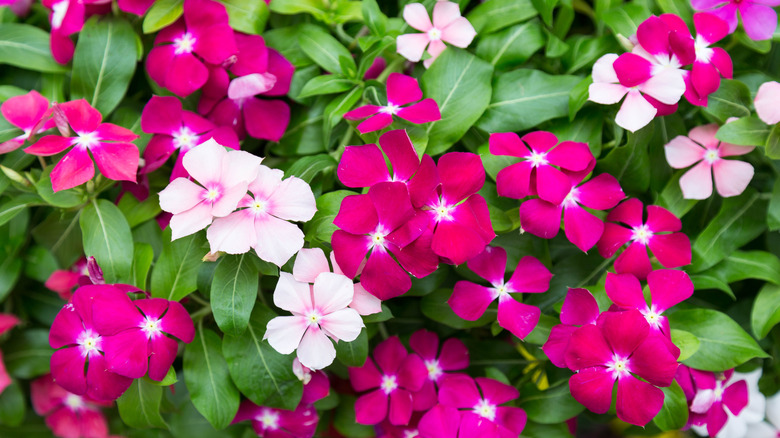How To Care For Vinca Flowers
Vinca flowers (catharanthus roseus) are drought and heat tolerant perennials frequently grown as annuals in numerous regions across the globe. If you're looking for a plant that's low maintenance, Gardeners Net wants you to know that one gardener shares that he's had vinca flowers every year in a single spot for three decades — with no help from him. The plant simply reseeds itself year in and out.
Also known as periwinkle, myrtle, and Madagascar periwinkle (although scientists point out that there's another independent periwinkle variety), vincas are native to India, China, Europe, and North America. These pest-resistant plants tend to grow 1 to 2 feet in height and bear single blooms of five overlapping petals. They're easily identified by their leathery green and glossy foliage as well as the blooms of their flowers, which range across the spectrum from white to pink and rose to red. Over time, botanists have developed new shades in tangerine, apricot, grape, and blackberry as well. You can expect them to bloom throughout the summer and generally until the first frost arrives.
How to use vinca flowers in garden
Vinca flowers are frequently seen in gardens as edging, borders, ground cover. or bedding plants. They're attractive to butterflies and resistant to deer and rabbits, too. Most commonly, they are grown from seed. Ask the professionals at Garden Design, and they'll recommend planting vincas in soil that's well-draining, and either with full sunlight exposure or partial shade. Once the weather has turned warmer for the season, plant your vincas in mid-to-late May or beyond in cooler climates. Should you prefer to grow yours from seeds, sow them between 10 weeks and three months before the last predicted frost, and refer to whatever guidance was provided in the packaging you were sold. Your seeds will perform to potential if the soil temperature is above 75 degrees Fahrenheit. Move your seedlings outdoors for transplanting once the outside temperatures hover consistently above 65.
Vincas are also partial to acidic soil (their preferred pH level is around 5.5), and do better in drought-like conditions than wet ones. Sandy or loamy soil that is well-draining is optimal. Plants should be spaced 8 to 12 inches apart to maximize airflow and decrease fungus risks.
If you prefer planting them in containers, vincas will perform in any well-draining, general-purpose potting soil. Adding a slow-release fertilizer to the mix will give them a boost as well. Remember that if you're thinking of combining your vincas with other perennials or annuals, it's best they have compatible exposure to sun and watering needs.
How to grow vinca flowers
Annual vincas are grown from seeds. With some sense of the approaching weather, sow your seeds in a pot indoors 90 or more days before the last predicted frost. Per Burpee, have your seller suggest seed-starters. Sow them in the formula, and cover your vincas with 1/8 inch more mixture. Don't overwater, but keep them somewhat moist. Grow them at temperatures between 75 and 78 degrees Fahrenheit, and you'll notice seedlings sprout in two to three weeks.
Once they've sprouted, place vincas on a windowsill for light. They'll grow beneath fluorescent lights (made for plants) that remain off eight hours daily and on for the remainder. As they grow, raise your lights. (Don't use incandescents; they put out too much heat.) Vincas also require some dark time, so don't leave your lights on for extended periods.
Smaller cells require moving your seedlings to pots before transplanting them outdoors to optimize root development. When transplanting, first move them outdoors to a spot away from wind and sun for the first week to help them adapt. Pick a spot with well-draining, moist soil in full sunlight. Turn the soil under at about 6 to 12 inches, remove debris, and lightly rake. Add compost, manure, leaf mold, then plant on a cloudy day to reduce shock. Plants should be 8 to 10 inches apart. Unpot the plant, gently loosen its root ball, and place it even with the surrounding soil level. Fill and tag the spot for location.
How to care for vinca flowers
Because vinca flowers favor drier soils, you should water them only when the surface soil's top inch feels dry or there's been inadequate rainfall to provide an inch of water a week. The experts at Hunker suggest that in terms of care, less may be more. They're often self-sufficient, although those in containers will require more attention than those embedded.
Typically, vincas don't require fertilization, unless you're aware that the soil they occupy is nutritionally deficient, in which case a 10-10-10 general purpose fertilizer is recommended and should be applied early in springtime. Again, a little goes a long way here: Every 100 square feet should get no more than 1/4 cup of fertilizer. Plants grown in containers could require more doses of liquid fertilizer. Pinching plants back is not at all necessary, but could provide a more robust appearance. The flowers are self-cleaning, so you won't be deadheading these.
Vincas are, however, susceptible to the stem and root rot caused by a water-and-soil-borne microorganism called Phytophthora. The best remedy: Simply provide the drainage they need and avoid overwatering. Vincas are also vulnerable to leaf spot diseases. You can help keep them hearty through morning watering and adequate air circulation.
Varieties of vinca flowers
There are a dozen identified species of vinca flowers, according to the Clemson Home and Garden Information Center. All are known thanks to their single flowers and opposite leaves, although the outlet contends the perennial periwinkle is often confused with the Madagascar periwinkle, a bedding plant known by is scientific name, catharanthus roseus.
Garden Guides categorizes vincas simply and distinctly.
- Vinca Major is the larger and more aggressive of the two best-known variants, with leaves that can reach up to 3 inches long and flowers reminiscent of pinwheels that can grow to 2 inches from side-to-side. Their funnel-shaped blue flowers generally range from 1 to 2 inches around. They're considered invasive and often mound to a height of nearly 2 feet. As an evergreen perennial, the plant can withstand temperatures as low as 20 degrees Fahrenheit. It's apopular pick for ground cover, because wherever it comes in contact with the ground, it roots.
- Likewise, Vinca Minor is ideal in providing evergreen ground cover. It's distinguished by its oval-to-oblong leaves, and known to discharge a milky liquid if broken. Most often, its flowers are blue, purple or white.
Are vinca flowers toxic?
Seductive as they may be to the eye, vinca flowers are considered toxic. Plant Addicts makes a series of important distinctions, though: Vinca Major and Vinca Minor seldom demonstrate mild toxicity, they say. However, the catharanthus roseus variety is highly poisonous to cats, dogs, humans, and horses. Catharanthus roseus has the same alkaloids used to treat diabetes and high blood pressure. In chemotherapy, they're used to kill cancer cells. But they are poisonous if ingested, and while it's safe enough to handle them, it's what you might handle next that prompts the site to advise washing your hands after handling these plants.
Every part of the plant is poisonous. More than 130 compounds of chemicals are found inside vincas, including vinblastine and vincristine, both of which attach to cells and interfere with cellular division, which in turn restricts blood vessel development and results in cellular death. Luckily, vincas are not appetizing and because that's so, they aren't usually ingested in large enough quantities to cause fatalities. Poisoning symptoms range from lack of coordination, depression, and vomiting to cardiac complications and in the most severe cases, death. Clearly you want to keep these plants as far away as possible from pets and children.
If you suspect your pet or child has ingested any part of the plant, look for bits remaining around their mouths and possible bite marks or plant parts torn away. Then immediately contact a poison control professional, whether a veterinarian or 911.
How to repot vinca flowers
If you consult the florists at eHow, they'll explain that transplanting vinca is comparatively easy. Start by planting your container-grown vinca or rooted cutting at a level similar to its previous residence, whether that was potted or in soil. Next, work the soil loose around the edges of the plant's roots, and trim those extraneous roots with a pruner or scissors you've sterilized with Lysol or rubbing alcohol before moving the vine of a vinca flower.
Once your operation is complete, you can backfill the area with the soil you've just excavated and tamp it all gently back together again. Take the opportunity to water thoroughly in order to help the plant adjust in its new soil, then add more compost or dirt as required to cover your root ball adequately. Again, once you're done, that's pretty much it. You'll want to follow the care instructions above.
